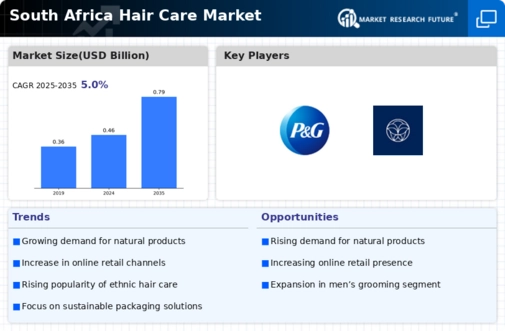South Africa Hair Care Size
South Africa Hair Care Market Growth Projections and Opportunities
The dynamics of South Africa's hair care market are shaped by a multitude of factors, including cultural influences, socioeconomic conditions, technological advancements, and changing consumer preferences. One significant aspect influencing market dynamics is the diverse cultural landscape of South Africa. With a rich tapestry of ethnicities and hair types, the country's hair care market caters to a wide range of needs and preferences. Different ethnic groups have distinct hair care practices and traditions, leading to a demand for specialized products tailored to specific hair textures, styles, and maintenance routines.
Socioeconomic conditions also play a pivotal role in shaping the dynamics of the hair care market in South Africa. Income levels, urbanization, and access to education and employment opportunities influence consumer spending habits and purchasing power. As disposable incomes rise and the middle class expands, consumers are more willing to invest in premium hair care products and salon services. Conversely, lower-income consumers may prioritize affordability and seek value-for-money options in the mass-market segment. Additionally, urbanization trends contribute to the growth of the professional salon industry, driving demand for professional-grade hair care products and services.
Technological advancements and innovations in hair care products and treatments drive market dynamics in South Africa. Companies invest in research and development to create advanced formulations, ingredients, and delivery systems that offer superior performance, efficacy, and safety. From shampoos and conditioners to styling products and treatments, technological innovations enable brands to differentiate their offerings, address specific hair care needs, and stay ahead of the competition. Additionally, advancements in manufacturing processes, packaging design, and sustainability initiatives contribute to market dynamics by enhancing product quality, shelf appeal, and environmental sustainability.
Changing consumer preferences and lifestyle trends also shape the dynamics of the hair care market in South Africa. As consumers become more health-conscious and environmentally aware, there is a growing demand for natural and organic hair care products free from harsh chemicals, sulfates, and parabens. Brands that prioritize sustainability, ethical sourcing, and cruelty-free practices resonate with environmentally conscious consumers, driving market growth in the natural hair care segment. Moreover, shifting beauty standards and fashion trends influence consumer preferences for hair colors, styles, and textures, driving demand for products that enable self-expression and creativity.
Distribution channels and retail landscapes contribute to the dynamics of the hair care market in South Africa. Traditional retail channels, such as supermarkets, pharmacies, and specialty beauty stores, remain dominant, offering a wide selection of hair care products to consumers. However, the rise of e-commerce platforms and online retailing has transformed the way consumers shop for hair care products, offering convenience, accessibility, and a diverse range of options. Brands that leverage omnichannel strategies and embrace digital marketing initiatives can reach a broader audience and drive sales growth in the competitive online marketplace.
Furthermore, regulatory frameworks and industry standards impact market dynamics in the hair care industry. Regulations governing product labeling, safety, and advertising influence product formulations, packaging claims, and marketing practices. Compliance with regulatory requirements is essential for brands to maintain consumer trust, ensure product safety, and avoid legal liabilities. Additionally, industry associations, professional organizations, and certification bodies play a role in setting industry standards, promoting best practices, and fostering innovation and collaboration within the hair care market.






Leave a Comment